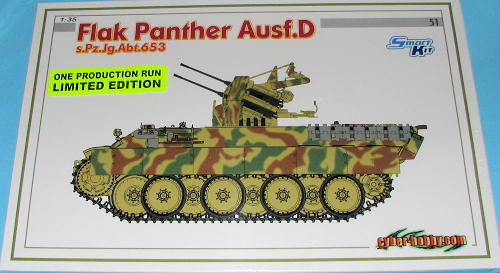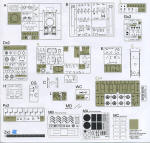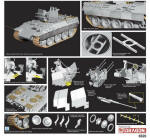
CyberHobby 1/35 Flak Panther ausf D
| KIT #: | 6626 |
| PRICE: | $71.00 MSRP |
| DECALS: | One option |
| REVIEWER: | Scott Van Aken |
| NOTES: | Smart Kit. One production run. |

| HISTORY |
The Panther was a direct response to the Soviet T-34. First encountered on 23 June 1941, the T-34 decisively outclassed the existing Panzer IV and Panzer III. At the insistence of General Heinz Guderian a team was dispatched to the Eastern Front to assess the T-34. Among the features of the Soviet tank considered most significant were the sloping armor, which gave much improved shot deflection and also increased the effective armor thickness against penetration, the wide track and large roadwheels which improved mobility over soft ground, and the 76.2 mm gun, which had good armour penetration and fired an effective high-explosive round. Daimler-Benz (DB) and Maschinenfabrik Augsburg-Nürnberg AG (MAN) were tasked with designing a new thirty to thirty-five-ton tank, designated VK3002, by April 1942 (apparently in time to be shown to Hitler for his birthday).
The two proposals were delivered in April 1942. The Daimler-Benz (DB) design was a direct homage to the T-34, side-stepping the German propensity for over-engineering and, hence, complexity, to produce a clean, simple design resembling the T-34 in hull and turret form, diesel engine, drive system, leaf spring suspension, track layout, and other features. In the DB design, like the T-34 design, the internal crew layout provided for two men: the commander would also have to serve as the gunner. This provided the advantage of a smaller, inexpensive turret design, as well as manpower savings, and a smaller target for enemy gunners to hit during a battle.
The MAN design was more conventional German thinking: it was higher and wider with a substantial turret placed centrally on the hull, a petrol engine, torsion-bar suspension, and a characteristically German internal crew layout for three men: commander, gunner, and loader. The MAN design was accepted in May, 1942 in spite of Hitler's preference for the DB design. One of the principal reasons for this was that the MAN design used an existing turret designed by Rheinmetall-Borsig while the DB design would have required a brand new turret to be designed and produced, substantially delaying the commencement of production.
A mild steel prototype was produced by September 1942 and, after testing at Kummersdorf, was officially accepted. It was put into immediate production with the very highest priority. The start of production was delayed, however, mainly because there were too few specialized machine tools needed for the machining of the hull. Finished tanks were produced in December and suffered from reliability problems as a result of this haste. The demand for this tank was so high that the manufacturing was soon expanded out of MAN to include Daimler-Benz and in 1943 the firms of Maschinenfabrik Niedersachsen-Hannover (MNH) and Henschel & Sohn in Kassel.
The initial production target was 250 tanks per month at MAN. This was increased to 600 per month in January 1943. Despite determined efforts this figure was never reached due to disruption by Allied bombing, manufacturing bottlenecks, and other difficulties. Production in 1943 averaged 148 per month. In 1944, it averaged 315 a month (3,777 having been built that year), peaking with 380 in July and ending around the end of March 1945, with at least 6,000 built in total. Strength peaked on September 1, 1944 at 2,304 tanks, but that same month a record number of 692 tanks were reported lost (source: T.L. Jentz (1999) Die deutsche Panzertruppe Band 2).
The ausf D was the initial production version with less than 700 built. Many of these used zimmerit paste until it was discontinued in mid-late 1944. Apparently at least one was converted to a mobile Anti-Aircraft platform, though I have to say that I could find nearly nothing about it during the usual search. Perhaps more were built, but it is unknown.
| THE KIT |
 I have heard that this kit is based on the later Panther A kit in terms of major assemblies and not the older Panther D. The gun assembly looks exactly like the one that came with the Sd.Kfz 7 kit released a few months back and if so, it is a good one.
I have heard that this kit is based on the later Panther A kit in terms of major assemblies and not the older Panther D. The gun assembly looks exactly like the one that came with the Sd.Kfz 7 kit released a few months back and if so, it is a good one.
The kit box does not tout many of the features, but those that struck me were the nicely done side skirts and their attachment brackets which are done in photo-etch to make them nice and scale. There is also what I guess is a standard P anther fret for engine intake grilles and a few other small bits. I was also impressed with how nicely the quad 20mm gun pieces were molded. The armor plating is properly thin and thanks to slide mold technology, the gun barrels themselves are very nice done with hollow ends. Of course, the DS tracks are a real boon to those who are not wholly fond of separate links.
anther fret for engine intake grilles and a few other small bits. I was also impressed with how nicely the quad 20mm gun pieces were molded. The armor plating is properly thin and thanks to slide mold technology, the gun barrels themselves are very nice done with hollow ends. Of course, the DS tracks are a real boon to those who are not wholly fond of separate links.
Another thing that struck me on this one is that the full size instructions are in full color. I don't recall seeing that before. The instructions are superbly illustrated with the usual notes and detail drawings we have come to expect. The small decal sheet covers one vehicle with s.Pz.Jg.Abt. 653 in overall panzer yellow with a random green and brown camouflage pattern.
| CONCLUSIONS |
Once again, CyberHobby has produced a kit that is both interesting and unusual. In case you haven't noticed a trend, it seems that kits with the quad AA are becoming popular. Since this is a one-time release, if you want one, you need to look into getting one soon.
| REFERENCES |
February 2010
Thanks to www.dragonmodelsusa.com for the preview kit. Get yours today at your local shop or on-line retailer.
If you would like your product reviewed fairly and fairly quickly, please contact the editor or see other details in the Note to Contributors.